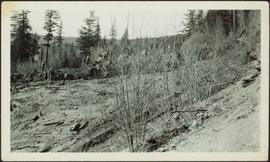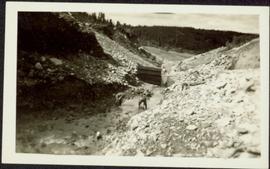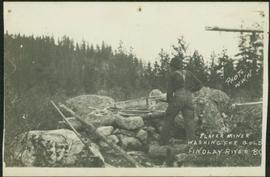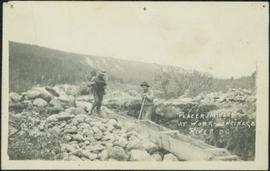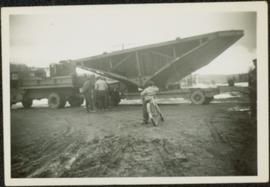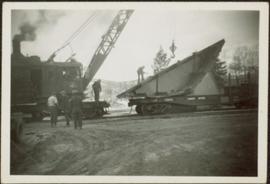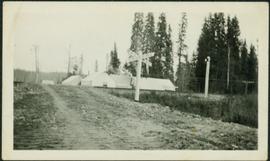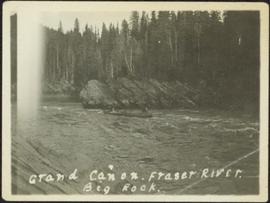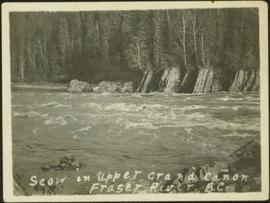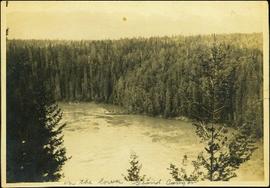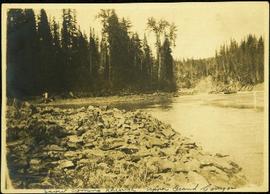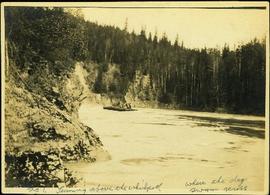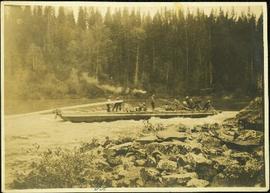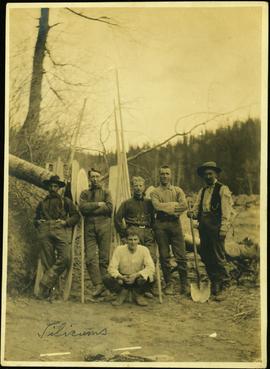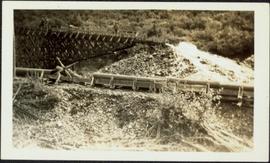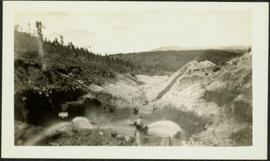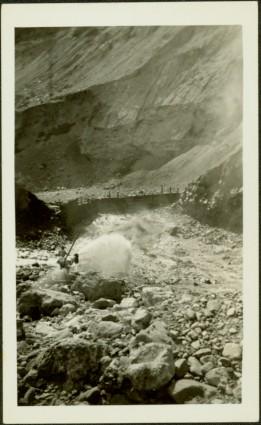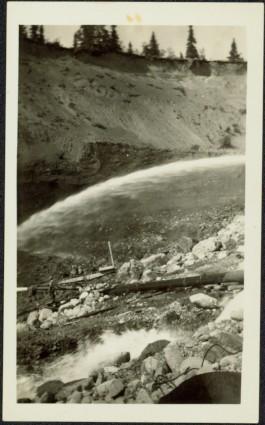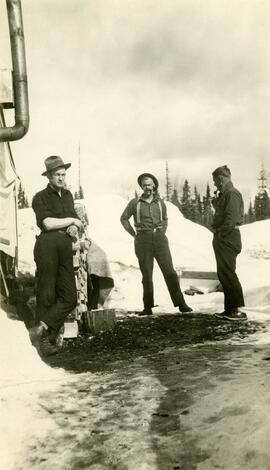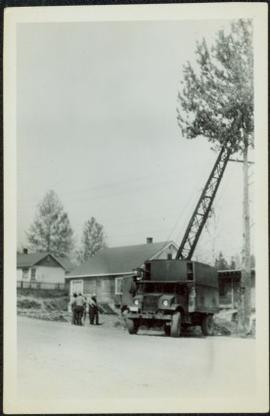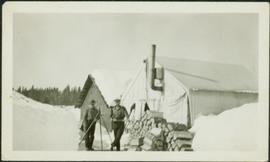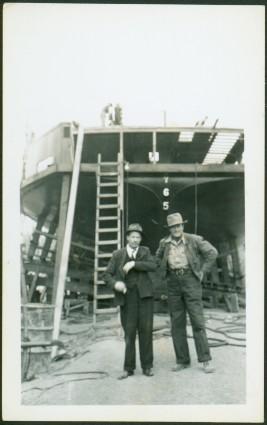Photograph depicts group of men working in unknown excavation area, possibly mining. Bushes in foreground, forest in background.
Photograph depicts three men panning in stream, sluiceway behind them. Rocky banks in foreground, forest in background.
Photograph depicts an unidentified man mining in rocky area, trees and hills in background. Handwritten annotations on verso of photograph: "PLACER MINER WSHING FOR GOLD FINDLAY RIVER BC", "PHOTO WWW".
Photograph depicts two miners standing on either side of wooden sluicing trough in rocky area. Man on left pans for gold. Hills in background. Handwritten annotations on verso of photograph: "PLACER MINERS AT WORK INGINECA RIVER BC", "PHOTO WWW".
Photograph depicts boy on bike, and group of men in front of hull on trailer pulled by truck. Railway tracks visible on right, forest and hills in background.
Photograph depicts a crane behind rail tracks on left, main hook block suspended above boat hull resting on railway flatbed. Group of men in foreground, one man on hull. Trees and hills in background.
Photograph depicts railway crossing in front of tent buildings. Dirt road in foreground, forest trees in background. Photograph speculated to have been taken in a construction camp at Prince George.
Photograph depicts men on river scow, large rock island or peninsula protruding into river behind them. Trees on opposite shore in background, large rock in foreground. Handwritten annotation on verso of photograph: "Grand Canyon. Fraser River. Big Rock.", on recto of copy print: "1911."
Photograph depicts men on river scow in distance. Rocks in foreground, trees and cliffs on opposite shore in background. Handwritten annotation on verso of photograph: "Scow in Upper Grand Canon. Fraser River. B.C.."
Photograph depicts men on a scow near opposite shore of river. Treetops in foreground. Photograph taken from above. Handwritten photo caption on verso and recto of this photo reads: "in the lower Grand Canyon".
Photograph depicts men on a scow in distance at bend in river. Unidentified objects or structures on opposite shore in background, rocky shore in foreground. Handwritten photo caption on verso and recto of this photo reads: "Scow coming through upper Grand Canyon".
Photograph depicts men on a scow, maneuvering what is believed to be the Upper Fraser River. Opposite shore in background, close shore in foreground. Handwritten photo caption below this photo reads: "1. Turning above the whirlpool where the dog swam across."
Photograph depicts a crew of 13 men on a scow believed to be maneuvering through the Upper Fraser River at Scow's Last Lap (Scow Rapids), downriver from the Grand Canyon of the Fraser. Trees on opposite shore in background, rocky shore in foreground. Handwritten annotation on recto of photograph reads: "the last lap".
Photograph depicts men standing in cleared dirt area, in front of oars and poles that lean against fallen tree trunk. One man holds a shovel, and forest trees can be seen in background. Handwritten annotation on verso and recto of this photograph reads: "Tilicums". It is is believed that this photograph was taken near the Upper Fraser River.
Photograph depicts sluice trunk in mining area, men on tall structure in background.
Photograph depicts man standing in front of large streams of water spraying from pipe into mining area, hills in background.
Photograph depicts a miner spraying enclosed area of river bed with water at high velocity. Cliffs in background.
Photograph depicts water being sprayed from pipes at high velocity in mining area. Unidentified man in midground, cliffs in background.
Photograph depicts three men standing in dirt area near fire wood. Tent building semi-visible on left, forest trees behind snow pile in background. Handwritten annotation on recto of photograph: "Relief camp at Penny. 100 men - A.K. Bourchier Foreman - Dixon Taylor timekeeper. [Ted Nevan?] purchasing agent - hungry thirties. Construction days. Mile 29 - A.K. Bourchier J.P." Man in middle is believed to be A.K. Bourchier.
Photograph depicts a group of men standing to right of large truck, houses in in background. Boom of crane visible between truck and houses. Trees and power lines also visible.
Photograph depicts two men standing in snow-cleared area next to firewood pile. Two tent buildings stand behind them, forest trees visible in background. Photograph taken at what is believed to have been a railway construction camp.
Photograph depicts two men standing in foreground, hull of unfinished ship in background. Construction supplies and materials throughout.
